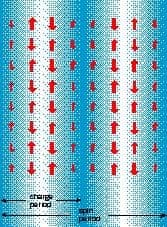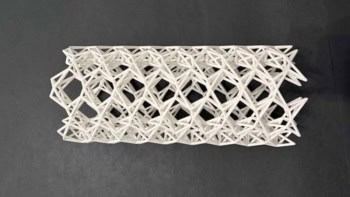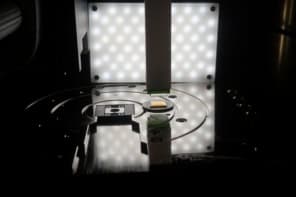
There is an old joke about a farmer who has a hen that will not lay eggs. After consulting unsuccessfully with a biologist, and then a chemist, he finally turns to a theoretical physicist. Several days later, the physicist announces that he has solved the problem: “First we assume a spherical chicken…” This story is a reminder that the art of approximation is crucial to most successful applications of theory to real problems; however, the proper level of simplification is not always obvious at the outset.
Differences in fundamental assumptions are behind much of the controversy among theorists over the cause of high-temperature superconductivity – the absence of resistance to electrical current at temperatures as high as 130 K – in layered copper-oxide compounds. One common assumption is that the charge carriers are distributed uniformly throughout the all-important CuO2 layers. However, there is growing experimental evidence that this is not the case and that “stripes” of charge form in these puzzling materials.
Now a significant step forward in the struggle to understand the behaviour of charge carriers in high-temperature superconductors has been made at the Oak Ridge National Laboratory in the US. Neutron-scattering experiments by Herb Mook of Oak Ridge and Fatih Do�gan from the University of Washington at Seattle suggest that charge stripes form instantaneously in a range of superconducting materials (Nature 1999 401 145). The results are intriguing because these stripes would have to occur in all the superconducting cuprates for them to be responsible for high-temperature superconductivity, as advocated by some theorists. Until now charge stripes had only been observed in a single cuprate system.
To understand why charge segregation may occur, it is useful to consider the parent copper-oxide compounds from which the superconductors are formed. The copper-oxide compounds are so-called “correlated insulators”, and are different from common insulators like silicon or sodium chloride in which the valence electron orbitals are either completely full or completely empty.
Rather than having full or empty orbitals, the copper atoms in the CuO2 planes each have one electron in the 3d level, so each copper atom has a net spin of 1/2. Normally one would expect these “unpaired” electrons to hop freely from one atomic site to another as in a metallic conductor, but this does not happen. Instead, the strong Coulomb repulsion between electrons prevents more than one of them from occupying the same site, so they tend to become localized. However, the ground-state energy of the compound can be lowered slightly if the unpaired electrons make “virtual” hops onto neighbouring sites and back again. Since the Pauli exclusion principle forbids electrons with the same quantum numbers being in the same place at the same time, this hopping is only possible when the spins of the unpaired electrons on neighbouring atoms are antiparallel. So it is therefore energetically favourable for the material to become antiferromagnetic. In other words, the antiferromagnetism that has been observed experimentally in the parent cuprates is a consequence of the correlated-insulator state.
Superconducting compounds are obtained from the parent cuprates by removing a small but finite density of electrons from the planes by chemical doping with, for instance, strontium for lanthanum. These missing electrons are commonly referred to as “holes”. If we assume, for simplicity, that each hole is associated with a copper atom, then an atom with a hole has no unpaired electron and no net spin. An unpaired electron from a neighbouring atom can readily hop onto a hole site, which allows the hole to move through the plane, lowering its kinetic energy. The accompanying rearrangement of the electrons results in clusters of parallel spins, and this costs magnetic energy relative to the antiferromagnetic state. Thus there is competition between the kinetic energy of the holes and the exchange energy of the spins.
Various experimental studies have demonstrated that antiferromagnetism survives in the doped cuprates. At the same time, however, superconductivity requires mobile charge carriers. How can mobile holes and local antiferromagnetism coexist? Several theorists have pointed out that the competing electronic interactions in the planes can lead to spatial segregation of the holes. In turn, neutron and X-ray diffraction studies on variants of the lanthanum strontium cuprate (La2 – xSrxCuO4), the prototypical copper-oxide superconductor, have shown that this segregation takes the form of regularly spaced stripes of charge separating the antiferromagnetic domains. The stripes are easiest to detect when they are static, but in such samples the superconducting transition temperature falls sharply. Some pro-stripe theorists have argued that the tendency towards charge segregation plays a crucial role in the hole-pairing mechanism essential to the superconductivity. On the other hand, sceptics have suggested that stripe order is a competing ground state that is incompatible with superconductivity.
If stripes are relevant to high-temperature superconductivity, they must be common to all of the superconducting cuprates. Furthermore, since static stripes appear to be bad for superconductivity, the stripes must also be dynamic. The search for experimental evidence for dynamic stripes is complicated by the fact that this is a brand new state of electronic matter of which we have no experience.
Recent inelastic neutron-scattering experiments on superconducting yttrium barium copper oxide (YBa2Cu3O6 + x) have found that the magnetic response is consistent with the dynamic-stripe model. The results are not conclusive, however, because the findings can be explained by alternative models in which the charge is distributed evenly throughout the material. To make the stripe interpretation more convincing, one needs evidence for the spatial modulation of the hole density. This is where the new work by Mook and Do�gan comes in.
Neutrons do not interact with charge carriers directly, but instead scatter from atomic nuclei. Static charged stripes cause displacements of the ions that make up the crystal lattice, and it is through such displacements that the stripes have been detected previously. The spatial period corresponding to the charge modulation, and hence the displacement pattern, is precisely half of the period of the magnetic modulation. This supports the idea that the charge is concentrated in the walls separating the antiferromagnetic domains. In contrast to the static case, dynamic charged stripes should alter lattice vibrations. (A lattice vibration is essentially a resonant mode of the lattice.) Mook and Do�gan studied a particular vibrational mode that should be affected by the stripes. They found an anomalous response at just the right spatial period one would expect for stripes, based on earlier magnetic scattering experiments. Thus the observed dependence of the resonance on the vibrational wavelength is circumstantial evidence for dynamic stripes.
Of course, the story will not end here. Sceptics will inevitably find alternative explanations or excuses to dismiss the new work, and experimentalists will continue to probe these mystifying materials. Nevertheless, the mounting evidence for magnetic and charge inhomogeneities indicates that this is not just a “stripe tease”, as it was called in New Scientist earlier this year, but rather a serious starting point for comprehending the cuprates.



